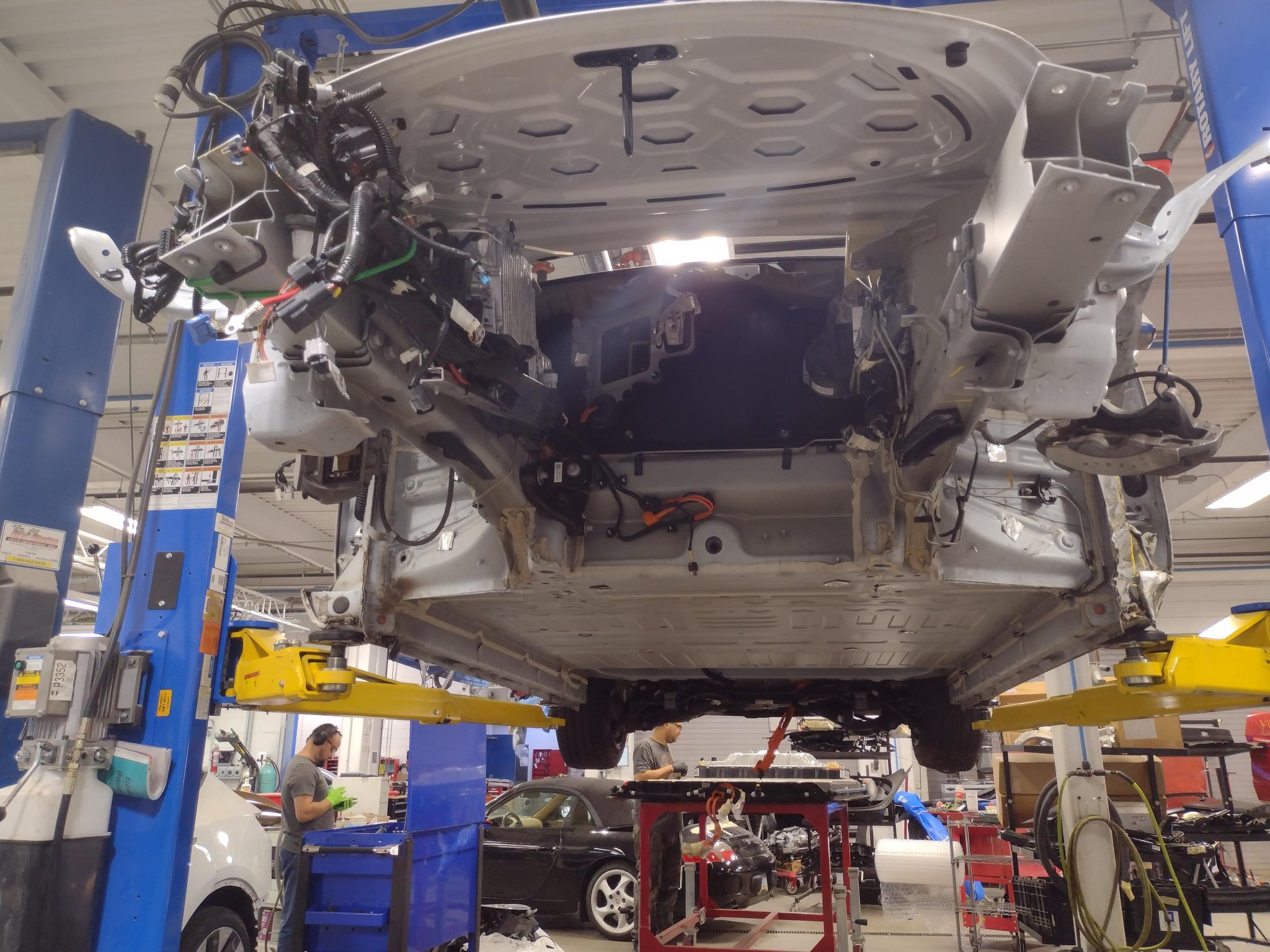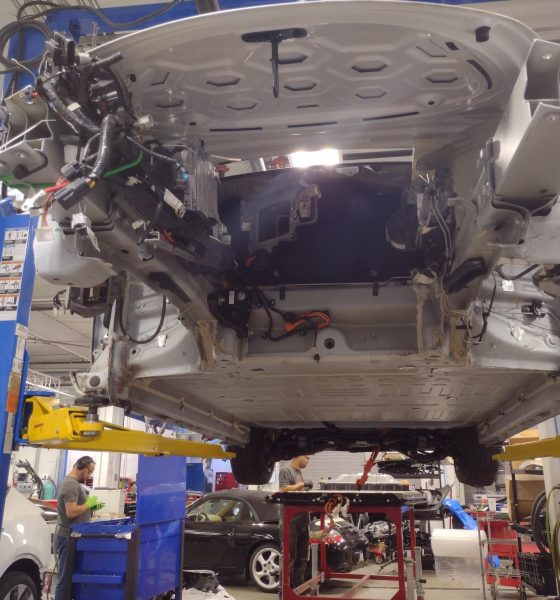

News
Tesla Cybertruck lead engineer shares insights on deep integration and vehicle development
Tesla Cybertruck Lead Engineer Wes Morrill recently shared some insights on the electric vehicle maker’s deep integration and unique approach to car design in a recent post on social media platform X. As could be seen in the engineer’s post, it is Tesla’s intense attention to detail that ultimately makes the company’s vehicles as disruptive as they are today.
Anyone informed who looks at the Tesla Cybertruck would know that the vehicle is a symphony of automotive engineering. Tesla, however, took some time before it reached this point. As per Morrill in his post, Tesla in its early days utilized different teams with collaborative goals in vehicle design. Adopting this system allowed the company to make great cars, but the designs of the vehicles themselves were not optimal.
“A well known example – early days of Tesla there was a battery team and separately a vehicle structures team. Structures team designed their vehicle body to meet given requirements of strength, crashworthiness, torsional stiffness, etc. Likewise, the battery team designed their part to be self contained, it could survive durability, accidentally being dropped, being hit in a crash, etc.
Good analysis – this is what happens when teams work together to make the best product. https://t.co/XAXf70k3jc— Wes (@wmorrill3) September 14, 2024
“As a result, we ended up with was a super dense battery in a strong box like structure, which was then Installed into the vehicle which had a nice space for it to mate into. There were no issues with integration, everything fit together perfectly and met all product goals. It achieved one of the highest crash safety ratings measured at the time.
“But we had a box full of battery cells that was installed into another empty box shaped receptacle on the body. A box in a box. When you simplify it down that far it sounds obviously wrong. The two organizations had achieved their goals, worked together without friction, and the product met its overall goals. Yet the product ended up with a clear lack of optimization as a result of the organizational boundaries of the two teams working in isolation. Nothing was wrong, but it wasn’t optimal,” Morrill wrote.
The Cybertruck Lead Engineer noted that Tesla learned from these experiences, and the company adapted. This is how innovations such as the structural battery pack—which is now being simulated by electric car makers in China—came about. Morrill stated, however, that such changes may require large organizational changes, and there has to be a drive to make the best product regardless of ego.
Have you heard of Conway's Law? It's an interesting observation about the root cause of why large organizations usually make products worse.
In 1967 Melvin Conway wrote "Organizations which design systems are constrained to produce designs which are copies of the communication… pic.twitter.com/SetWd6OfTe— Wes (@wmorrill3) September 14, 2024
“Before the next product was designed, the battery team gave responsibility of the battery structures also to the vehicle structures team. On this iteration, we ended up with the structural battery, which is an integral part of the body and crash structure. Without it, the vehicle body will not work. It’s the literal floor for the vehicle. But the redundancy is gone and the design is more efficient as a result. This vehicle also achieved one of the highest crash safety ratings measured at the time.
“This is a super obvious example (in retrospect) and solved with a fairly large organizational change but you can also see this happen in small technical decisions and doesn’t require structural change to fix. Someone just needs to question if there is a better solution in a team open to criticism. This mindset to work together to make the best product regardless of ego is where you end up with the most innovative products.
“Some smaller examples have been seen when inspecting Cybertruck design. The chassis air suspension which is used to pressurize the battery pack to prevent water ingress. The subwoofer which utilizes the air volume of the body side instead of making the enclosure larger. Centralized zonal vehicle controllers instead of many small distributed controllers. Doors which use the exterior surface as a crash intrusion beam. The pedestrian warning system used as a horn. The list goes on. The excitement and motivation by everyone involved to work across boundaries and actively break down Conway’s Law is one of the many reasons I love working at Tesla,” Morrill wrote.
Don’t hesitate to contact us with news tips. Just send a message to simon@teslarati.com to give us a heads up.

News
Tesla China delivery centers look packed as 2025 comes to a close
Needless to say, it appears that Tesla China seems intent on ending 2025 on a strong note.

Tesla’s delivery centers in China seem to be absolutely packed as the final days of 2025 wind down, with photos on social media showing delivery locations being filled wall-to-wall with vehicles waiting for their new owners.
Needless to say, it appears that Tesla China seems intent on ending 2025 on a strong note.
Full delivery center hints at year-end demand surge
A recent image from a Chinese delivery center posted by industry watcher @Tslachan on X revealed rows upon rows of freshly prepared Model Y and Model 3 units, some of which were adorned with red bows and teddy bears. Some customers also seem to be looking over their vehicles with Tesla delivery staff.
The images hint at a strong year-end push to clear inventory and deliver as many vehicles as possible. Interestingly enough, several Model Y L vehicles could be seen in the photos, hinting at the demand for the extended wheelbase-six seat variant of the best-selling all-electric crossover.
Strong demand in China
Consumer demand for the Model Y and Model 3 in China seems to be quite notable. This could be inferred from the estimated delivery dates for the Model 3 and Model Y, which have been extended to February 2026 for several variants. Apart from this, the Model Y and Model 3 also continue to rank well in China’s premium EV segment.
From January to November alone, the Model Y took China’s number one spot in the RMB 200,000-RMB 300,000 segment for electric vehicles, selling 359,463 units. The Model 3 sedan took third place, selling 172,392. This is quite impressive considering that both the Model Y and Model 3 are still priced at a premium compared to some of their rivals, such as the Xiaomi SU7 and YU7.
With delivery centers in December being quite busy, it does seem like Tesla China will end the year on a strong note once more.
News
Tesla Giga Berlin draws “red line” over IG Metall union’s 35-hour week demands
Factory manager André Thierig has drawn a “red line” against reducing Giga Berlin’s workweek to 35 hours, while highlighting that Tesla has actually increased its workers’ salaries more substantially than other carmakers in the country.

Tesla Giga Berlin has found itself in a new labor dispute in Germany, where union IG Metall is pushing for adoption of a collective agreement to boost wages and implement changes, such as a 35-hour workweek.
In a comment, Giga Berlin manager André Thierig drew a “red line” against reducing Giga Berlin’s workweek to 35 hours, while highlighting that Tesla has actually increased its workers’ salaries more substantially than other carmakers in the country.
Tesla factory manager’s “red line”
Tesla Germany is expected to hold a works council election in 2026, which André Thierig considers very important. As per the Giga Berlin plant manager, Giga Berlin’s plant expansion plans might be put on hold if the election favors the union. He also spoke against some of the changes that IG Metall is seeking to implement in the factory, like a 35-hour week, as noted in an rbb24 report.
“The discussion about a 35-hour week is a red line for me. We will not cross it,” Theirig said.
“(The election) will determine whether we can continue our successful path in the future in an independent, flexible, and unbureaucratic manner. Personally, I cannot imagine that the decision-makers in the USA will continue to push ahead with the factory expansion if the election results favor IG Metall.”
Giga Berlin’s wage increase
IG Metall district manager Jan Otto told the German news agency DPA that without a collective agreement, Tesla’s wages remain significantly below levels at other German car factories. He noted the company excuses this by referencing its lowest pay grade, but added: “The two lowest pay grades are not even used in car factories.”
In response, Tesla noted that it has raised the wages of Gigafactory Berlin’s workers more than their German competitors. Thierig noted that with a collective agreement, Giga Berlin’s workers would have seen a 2% wage increase this year. But thanks to Tesla not being unionized, Gigafactory Berlin workers were able to receive a 4% increase, as noted in a CarUp report.
“There was a wage increase of 2% this year in the current collective agreement. Because we are in a different economic situation than the industry as a whole, we were able to double the wages – by 4%. Since production started, this corresponds to a wage increase of more than 25% in less than four years,” Thierig stated.
News
Tesla is seeing a lot of momentum from young Koreans in their 20s-30s: report
From January to November, young buyers purchased over 21,000 Teslas, putting it far ahead of fellow imported rivals like BMW and Mercedes-Benz.

Tesla has captured the hearts of South Korea’s 20s-30s demographic, emerging as the group’s top-selling imported car brand in 2025. From January to November, young buyers purchased over 21,000 Teslas, putting it far ahead of fellow imported rivals like BMW and Mercedes-Benz.
Industry experts cited by The Economist attributed this “Tesla frenzy” to fandom culture, where buyers prioritize the brand over traditional car attributes, similar to snapping up the latest iPhone.
Model Y dominates among young buyers
Data from the Korea Imported Automobile Association showed that Tesla sold 21,757 vehicles to the 20s-30s demographic through November, compared to BMW’s 13,666 and Mercedes-Benz’s 6,983. The Model Y led the list overwhelmingly, with variants like the standard and Long Range models topping purchases for both young men and women.
Young men bought around 16,000 Teslas, mostly Model Y (over 15,000 units), followed by Model 3. Young women followed a similar pattern, favoring Model Y (3,888 units) and Model 3 (1,083 units). The Cybertruck saw minimal sales in this group.
The Model Y’s appeal lies in its family-friendly SUV design, 400-500 km range, quick acceleration, and spacious cargo, which is ideal for commuting and leisure. The Model 3, on the other hand, serves as an accessible entry point with lower pricing, which is valuable considering the country’s EV subsidies.
The Tesla boom
Experts described Tesla’s popularity as “fandom culture,” where young buyers embrace the brand despite criticisms from skeptics. Professor Lee Ho-geun called Tesla a “typical early adopter brand,” comparing purchases to iPhones.
Professor Kim Pil-soo noted that young people view Tesla more as a gadget than a car, and they are likely drawn by marketing, subsidies, and perceived value. They also tend to overlook news of numerous recalls, which are mostly over-the-air software updates, and controversies tied to the company.
Tesla’s position as Korea’s top import for 2025 seems secured. As noted by the publication, Tesla’s December sales figures have not been reported yet, but market analysts have suggested that Tesla has all but secured the top spot among the country’s imported cars this year.








